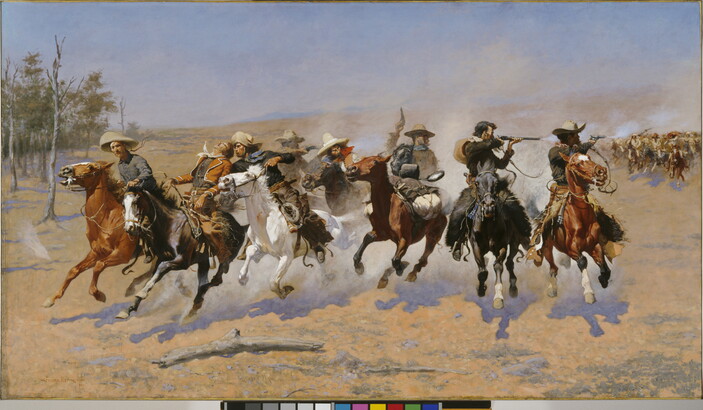





Artwork Images
Photo:
Controls
A Dash for the Timber
Object Details
-
Date
1889
-
Object Type
Paintings
-
Medium
Oil on canvas
-
Dimensions
48 1/4 x 84 1/8 in.
-
Inscriptions
Recto:
signed and dated l.l.: Frederic Remington \ 1889
signed and dated l.l. below existing signature: Frederic Re[illeg.] [illeg.]89
Verso:
label fragment on [removed] frame: AME[RICA]N ART ASSOCIAT[ION] \ 6 EA[ST] 23D STREET, M[AD]ISON SQUARE SOUTH, [torn] \ NEW [Y]ORK. \ S[torn] \ [torn] \ Artist o[torn] [torn] er_______ \ Addres[s] ________ \ Return ________ \ [E]xhibition 188[torn].
-
Collection Name
Amon G. Carter Collection
-
Credit Line
Amon Carter Museum of American Art, Fort Worth, Texas, Amon G. Carter Collection
-
Accession Number
1961.381
-
Copyright
Public domain
Object Description
Across an arid plain, eight men ride for cover. Just before reaching the trees, one keels over, having been struck by a bullet. Close behind, a group of Native Americans follows in hot pursuit, and it is not clear who will emerge victorious.
Remington executed this climatic scene after Harper’s Weekly sent him west from his home in New York to document army efforts to capture the Apache leader Geronimo. Following the trip, Remington devised this fictional scene to convey the bravery and comradery of western cowboys. The picture was a critical sensation, and it would shape future popular imaginings of western life. Despite its remarkable drama, A Dash for the Timber simplifies a more complex reality. Remington presents settlers and Indigenous peoples as incompatible, linked only through acts of violence. This visual rhetoric denies Native Americans their humanity, portraying them as the primary aggressors, and it obscures accounts of diplomacy and cross-cultural exchange that did not culminate in open conflict..
—Text taken from the Carter Handbook (2023)
-
Remington and RussellFebruary 25–May 24, 2015
This exhibition of paintings and sculptures selected from the Carter’s extensive collection offers visitors an opportunity to gain insight into the works of Frederic Remington and Charles M. Russell, two of the greatest practitioners of the art of the American West.
-
From Remington to O’Keeffe: The Carter’s Greatest HitsOctober 6, 2018–March 22, 2019
During the renovation, this exhibition features highlights from the permanent collection, including paintings, photographs, and sculptures, by some of America’s most renowned artists.
-
Mythmakers: The Art of Winslow Homer and Frederic RemingtonDecember 22, 2020–February 28, 2021
American icon Winslow Homer, famous ocean painter, joins Frederic Remington, legendary cowboy artist, for the first exhibition to explore the unexpected resonances and moments of convergence between the themes, artistic sensibilities, and technical processes of these two artists.
Additional details
Location: On view
Part of:
Amon G. Carter Collection
See more by Frederic Remington
Tags
Video:
-
What tools do artists use to convey a sense of movement and tension?
What role does setting play in a narrative painting?
How does an artist incorporate light into a work of art?
What impact does an artist's use of light and shadow have on the viewer's experience of an artwork?
What role do stereotypes play in an audience’s understanding of works of art?
-
Grades Pre-K–3
Students will explore motion in art by using only lines to draw the movements seen in the painting (wavy lines for gallop, forward slash for leaning, spiral for turning cowboy, etc.).
Grades 3–5
Students will explore the beginning, middle, and end in narratives. They will imagine they are one of the people in this painting. Using carefully chosen words, they should describe their adventurous day to a friend.
Grades 3–8
Show a photograph of Fredric Remington and drawings he made of horses. What is important about the horses in this painting? Share motion studies (or a flipbook) of horses by Eadweard Muybridge.
On 2-by-12 inch paper, students can create a series of drawings depicting movement.
Share Educator Resources
Amon Carter Disclaimer
This information is published from the Carter's collection database. Updates and additions based on research and imaging activities are ongoing. The images, titles, and inscriptions are products of their time and are presented here as documentation, not as a reflection of the Carter’s values. If you have corrections or additional information about this object please email us to help us improve our records.
Every effort has been made to accurately determine the rights status of works and their images. Please email us if you have further information on the rights status of a work contrary or in addition to the information in our records.
Related Works
-
Green Nude, ca. 1918-1924
Gaston Lachaise
Crayon on paper
2018.4
-
Sunrise, Yosemite Valley, ca. 1870
Albert Bierstadt
Oil on canvas
1966.1
-
Self-Portrait, 1919
Stuart Davis
Oil on canvas
1975.29
-
Blips and Ifs, 1963-1964
Stuart Davis
Oil on canvas
1967.195
-
Ranchos Church, New Mexico, 1930-1931
Georgia O'Keeffe
Oil on canvas
1971.16
-
Untitled (Pittsburgh Housing), 1930s
Manuel de Aumente
Gelatin silver print
P2009.11
-
Zerogram, 2017
Ellen Carey
Dye coupler print
P2018.40
-
The Time Game, 2011
Jane Hammond
Gelatin silver print
P2011.29
-
A Closet Door, 1904-1906
John Frederick Peto
Oil on canvas
1983.158




